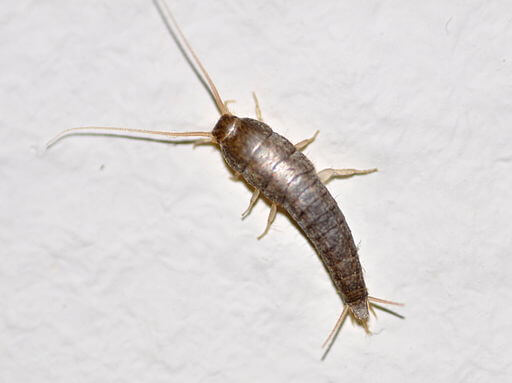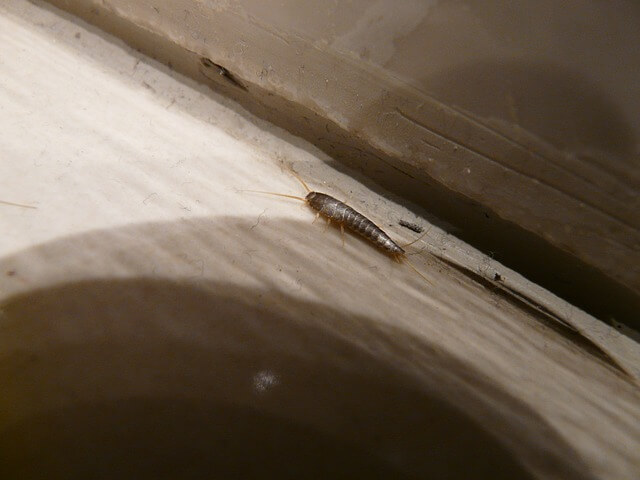If you’re reading this and have no idea what a silverfish is in the first place, first of all, if the image we featured here isn’t already too obvious, a silverfish is not a silver fish that’s somehow defrosted itself, got out of your refrigerator, and started flopping all over your kitchen floor (if that did happen, it would get posted on YouTube for sure!). No, silverfish are actually little varmints that infest homes, apartment buildings, and basically any structure that’s warm, moist, dark, and cozy. Sometimes silverfish get confused with a few other common pests: the centipede and the firebrat.
If this creepy crawler looks anything like something you’ve seen recently, you’re going to need help getting them out of your home. Here’s what else you need to know about these pesky pests.
(Also, a fun fact: silverfish are actually older than even roaches prehistorically speaking. You thought lizards and birds were the only dinosaurs? Turns out you were way off.)
About the Silverfish
Silverfish mainly decide to nest in the walls or around drain pipes, specifically anywhere that is dark and damp such as the kitchen, bathroom, attic, and basement. They usually pop out for a visit at night when it’s dark rather than during the daytime; they’re the insect kingdom’s night owls. So, it’s not uncommon to not realize you have a silverfish problem in the first place unless it’s by pure chance.
A silverfish diet mostly consists of breadcrumbs, food crumbs, dust, paper, damp clothes, leather clothes, and book bindings—basically, your bookshelf is their dinner table (sorry to any book lovers out there!).
Silverfish females are slow to reproduce, laying only 60 eggs a year and 100 eggs on average in their lifetime. However, they live long enough to cause some damage to your books and wallpaper, about 5 years!
“Are they poisonous?” you ask? The answer is no, luckily, they are not. In the odd chance your pet finds a silverfish and eats one, it’s okay—it doesn’t mean you have to rush them to the vet. Silverfish are not toxic to pets or humans. However, silverfish make a great dinner for more poisonous varmints such as spiders and, if you’re especially unlucky, cockroaches—both which carry venom and diseases. So, tell those venomous and disease-ridden varmints that dinner is cancelled by getting rid of their main menu.

Oh, hey … fancy seeing you here! – via Wikipedia
Signs You’ve Got an Infestation
The most obvious sign is that once you’ve seen one in existence, it’s a possibility that it’s either a straggler or there is a million more where it came from. Be aware as well of these telltale signs of a potential infestation:
- Droppings. Their feces actually appear and look out of the ordinary, resembling peppercorn pieces (ie black and spherical).
- Holes in your books (especially in the middle), wallpaper, office papers, and any cardboard boxes you have in storage. This is a clear sign the silverfish have found their next meal.
- Inexplicable yellow stains on your clothes—because you know, when you gotta go…you know the rest.
- Shedded skin, which camouflages really well with any dust or debris hanging out in your bathroom or kitchen.
- Increased holes and gaps in your home’s plaster, baseboards, window sills, etc.
How Did They Get In My House ?!
Simple: silverfish love to travel, and their favourite means of transportation is by book and box. Usually, an infestation can begin in the garage, attic, or basement where lots of cardboard boxes are kept in storage. These are the likeliest places where they can make their new home safely since they’re a big fan of carbohydrates. Mmm, bread…
Anyway, indoors is not the only place where you’ll likely find silverfish. You may find most of them hiding out in the shed (like we said, the darker and damper, the better) or even your garage.
I Don’t Have an Infestation but I’m Worried! How Do I Keep Silverfish Out?
If you see the odd one and are freaking out, don’t panic! Like we said, silverfish aren’t toxic nor are they interested in biting or stinging you on purpose (unlike its mistaken identity, the centipede…). However, there is, unfortunately, no real preventative solution to getting rid of silverfish. Once you’ve found one, odds are high that a whole lot more are getting themselves comfortable in your home. There are articles online that say you can use preventatives, but these are only short-term solutions to the big picture, which is that your belongings—especially the books—are at risk of being eaten.
The only real way you can get rid of these varmints is by calling your local Pest Boss. Treatment is literally the only way you can minimize the risk of silverfish from making their home in yours. That way, you won’t have to worry about them nibbling away at your copy of Chicken Soup for the Soul.
Creative Commons Attribution: Permission is granted to repost this article in its entirety with credit to Pest Boss and a clickable link back to this page.


